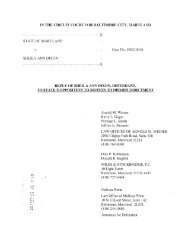Memorandum Opinion - the Circuit Court for Baltimore City
Memorandum Opinion - the Circuit Court for Baltimore City
Memorandum Opinion - the Circuit Court for Baltimore City
You also want an ePaper? Increase the reach of your titles
YUMPU automatically turns print PDFs into web optimized ePapers that Google loves.
sending an email to Strudwick “rise to <strong>the</strong> level” of purposefully availing oneself of <strong>the</strong>privilege of conducting activities in Maryland. See Bond, 391 Md. at 731.The February 17, 2007 letter sent to Strudwick suffers from <strong>the</strong> same defects as <strong>the</strong>email sent to Strudwick: it may be relevant evidence in a trial, but plaintiffs’ claims do notarise out of that letter. Plaintiffs have not alleged any facts to show that <strong>the</strong> letter injuredplaintiffs. And as discussed earlier, sending correspondence into <strong>the</strong> state, without more, isnot “purposefully availing” oneself of <strong>the</strong> privilege of conducting activities in <strong>the</strong> state. Thus<strong>the</strong> letter is not relevant to determining if Maryland has jurisdiction.The website and emails sent to Maryland WIN studentsThe remaining contacts that plaintiffs assert subject defendants to <strong>the</strong> jurisdiction ofthis <strong>Court</strong> are <strong>the</strong> website, “BARRYBUSTED.com,” and <strong>the</strong> email flyers sent to <strong>the</strong> 35 WINstudents, which included seven Maryland residents. These contacts once again illustrate how“technology brings new challenges to applying <strong>the</strong> principles of personal jurisdiction.”MaryCLE, LLC v. First Choice Internet, Inc., 166 Md. App. 481, 500 (2006) (citation andinternal quotation marks omitted). Once upon a time, a person’s “presence within <strong>the</strong>territorial jurisdiction of a court was prerequisite to its rendition of a judgment personallybinding him.” Int’l Shoe Co. v. Washington, 326 U.S. 310, 316 (1945) (citations omitted).This requirement of physical presence, however, evolved into a more flexible standardknown today as “minimum contacts.” Id. at 316. Over 50 years ago, be<strong>for</strong>e <strong>the</strong> internet wasimagined, <strong>the</strong> Supreme <strong>Court</strong> recognized that advances in communication technologyexpanded <strong>the</strong> “permissible scope of personal jurisdiction.” McGee v. Int’l Life Ins. Co., 355U.S. 220, 222-23 (1957). See also Hanson v. Denckla, 357 U.S. 235, 250-51 (1958)(“progress in communications and transportation has made <strong>the</strong> defense of a suit in a <strong>for</strong>eign22
















